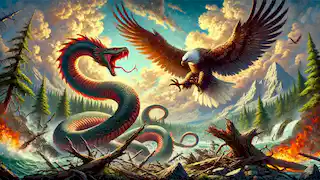The Story of the Great Serpent
Reading Time: 9 min
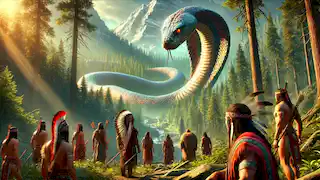
About Story: The Story of the Great Serpent is a Legend from canada set in the Ancient. This Descriptive tale explores themes of Courage and is suitable for All Ages. It offers Educational insights. A legendary battle between man, nature, and the Great Serpent.
In the ancient days, when the world was still young, and the land was pure and untamed, there existed creatures of unimaginable power. Among these was the Great Serpent, known by many names among the tribes, each fearing and revering its might. Some called it "Uktena," the horned serpent; others whispered "Mishipeshu," the water panther, while others still knew it simply as the protector or destroyer, depending on which side of its wrath one found themselves.
For centuries, the Great Serpent slithered through rivers, across mountains, and under the earth itself, commanding nature and time with its sheer presence. The creature was colossal, its body winding around the hills and valleys like rivers of muscle and scale, glittering in the sunlight or glowing in the darkest nights. Its eyes were said to burn like embers, piercing through the shadows of the world, seeing all that moved.
The story of the Great Serpent begins with the people of the forest, a tribe that lived in harmony with nature. They were hunters, gatherers, and dreamers. They believed that the earth spoke to them in ways only their shamans could truly understand. These wise ones would listen to the wind, interpret the flight of birds, and hear the whispers of the rivers. It was said that they were the first to hear the Great Serpent's voice, carried on the wind like a warning, or perhaps a call. Long before the Great Serpent was known to the tribe, it was believed to be a myth, a story told to children by the firelight. It was said that the Serpent slumbered deep beneath the mountains, resting in the belly of the earth, waiting for a time when it would rise again to reshape the world. The shamans spoke of a great dream—a vision shared by many—that foretold of a day when the Serpent would wake and either bring great prosperity or great destruction. In those early days, the tribe prospered. The forest was bountiful, the rivers clear, and the animals plentiful. The people lived in peace, guided by the wisdom of their elders and the strength of their warriors. But as the seasons turned, things began to change. The animals grew scarce, the rivers became darker, and strange omens began to appear. Birds would fly in erratic patterns, wolves howled in the day, and the sky itself seemed darker, even at noon. It was during this time of uncertainty that the tribe’s most powerful shaman, a woman named Mahala, received a vision. She dreamt of a massive serpent rising from the earth, its eyes glowing like two suns, its hiss shaking the very foundations of the world. In her dream, the Serpent spoke to her. It told her that the time of its awakening was near and that the tribe must prepare. Mahala woke in terror, knowing that the balance of their world was about to be shattered. The days that followed were filled with tension. Mahala called for a great council, gathering not only her own people but the neighboring tribes who also lived in the shadow of the mountains. These were proud peoples, each with their own customs and beliefs, but all shared the same land and its legends. It took time for them to agree to come together, for many were skeptical of Mahala’s vision. Some thought it was just a dream, while others feared that speaking of the Serpent would bring its wrath sooner. But as more and more signs appeared—animals disappearing, the sky darkening, and the earth trembling beneath their feet—the tribes knew that something was coming. The leaders of each tribe met under the sacred tree, a massive oak that was said to have stood since the beginning of time, and there they debated what should be done. Mahala stood before them, her eyes fierce with conviction. She told them that the Great Serpent was not only a force of destruction but also one of creation. It had the power to reshape the world, to bring new life or to take it away. The key, she said, was balance. The Serpent must be respected, appeased, and understood. If they could find a way to live in harmony with it, they might avert disaster. But not all agreed. Some believed that the Serpent should be fought, that it was a demon sent to test their strength. Others thought that they should flee, abandoning the land that had sustained them for generations. After many days of debate, it was decided that a group of warriors, led by the bravest from each tribe, would seek out the Great Serpent. They would journey to the heart of the mountains, where it was said to sleep, and there they would either make peace with it or prepare to fight. The journey to the mountains was perilous. The group, numbering twelve in total, included warriors, hunters, and shamans, each chosen for their unique skills. Mahala herself led the group, carrying with her sacred items meant to communicate with the spirit world, for she believed that only through spiritual means could they hope to reason with the Serpent. As they ventured deeper into the mountains, the signs of the Serpent’s power became more apparent. The rivers they crossed were poisoned, the fish floating lifeless on the surface. The trees around them withered as if something had drained the very life from them. The air grew colder, though it was the middle of summer, and strange sounds echoed through the valleys at night. On the third night of their journey, they camped near a large lake at the base of the tallest mountain. As they sat around the fire, discussing their next steps, a low rumble shook the ground. The lake’s surface began to ripple, and from its center, a massive shape began to rise. The Great Serpent had awakened. The warriors drew their weapons, ready to fight, but Mahala stepped forward, raising her hands in a gesture of peace. The Serpent’s head loomed above them, its eyes glowing, its scales shimmering in the moonlight. It was larger than any creature they had ever seen, its body coiled in the water like an endless river. Mahala spoke to the Serpent in the ancient tongue, a language known only to the shamans. She offered it gifts—feathers, stones, and sacred herbs—symbols of peace and respect. For a moment, the Serpent seemed to consider her words. Its massive eyes narrowed, and it lowered its head closer to the shore. But just as it seemed that peace might be possible, something happened. One of the warriors, overcome with fear, threw his spear at the Serpent. The weapon struck its scales and bounced harmlessly off, but the damage was done. The Serpent reared back, hissing in fury. Its tail lashed out, sending waves crashing onto the shore, and the ground shook beneath their feet. The warriors scattered, trying to avoid the Serpent’s wrath. The battle that followed was fierce and chaotic. The warriors, though skilled, were no match for the Great Serpent. It moved with terrifying speed and power, its massive body crashing through the trees and sending boulders tumbling down the mountainside. Several of the warriors were thrown into the lake, their cries lost in the roar of the water. Mahala, seeing that violence had only angered the Serpent, desperately tried to calm it. She called out to the spirits of the earth and sky, begging for their help. She chanted prayers and threw sacred herbs into the air, hoping to appease the beast. But the Serpent was beyond reason. It had been woken in anger, and now it sought only destruction. As the battle raged on, it became clear that the warriors could not defeat the Serpent. One by one, they fell, their bodies broken by the Serpent’s massive coils or crushed under the weight of falling trees. Only Mahala and a few others remained, standing on the edge of the lake, their weapons useless against the creature’s impenetrable scales. But just as all hope seemed lost, something miraculous happened. The sky, which had been dark and stormy since the Serpent’s awakening, suddenly cleared. A bright light appeared, shining down on the lake. From the light, a figure emerged—an ancient spirit, known to the tribe as the Great Eagle, the protector of the land. The Great Eagle swooped down from the sky, its wings spread wide, and with a mighty cry, it struck the Serpent. The two great creatures clashed, their battle shaking the very earth. The Serpent hissed and lashed out with its tail, but the Eagle was too quick, darting in and out of reach, its talons tearing at the Serpent’s scales. For what seemed like hours, the battle raged. But in the end, the Great Eagle proved victorious. With one final strike, it drove its talons into the Serpent’s head, and with a deafening roar, the Serpent collapsed, its massive body sinking back into the lake. The survivors, bloodied and exhausted, watched as the Great Eagle circled above the lake one last time before disappearing into the clouds. The Serpent was gone, its body resting at the bottom of the lake, but the damage it had caused would take generations to heal. The land had been scarred, the rivers poisoned, and many brave warriors had been lost. But Mahala knew that the battle had not been in vain. The Great Eagle had saved them, and the Serpent’s death meant that balance could be restored to the land. The tribes, though divided by the conflict, would come together to rebuild, to heal the wounds left by the Great Serpent. And so, the story of the Great Serpent became a legend, passed down from generation to generation. It was a story of warning, of respect for the forces of nature, and of the need for balance. The tribes never forgot the lessons learned that day, and they honored the Great Serpent, not as an enemy, but as a reminder of the power of the world around them. Though the Serpent no longer roamed the land, its spirit lived on in the rivers, the mountains, and the hearts of the people. They knew that, one day, the Serpent might rise again, and when it did, they would be ready.The Birth of the Legend
The Gathering of the Tribes
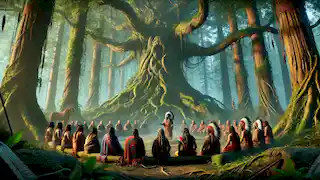
The Journey to the Mountains
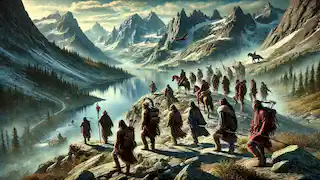
The Battle with the Serpent
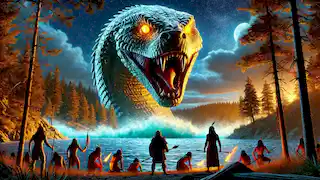
The Aftermath
